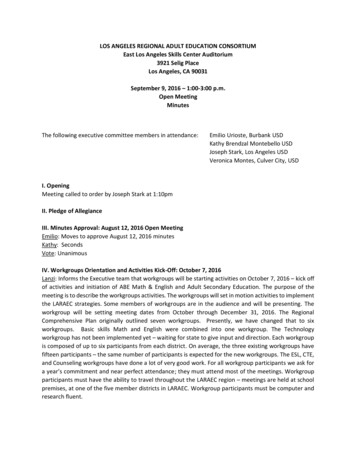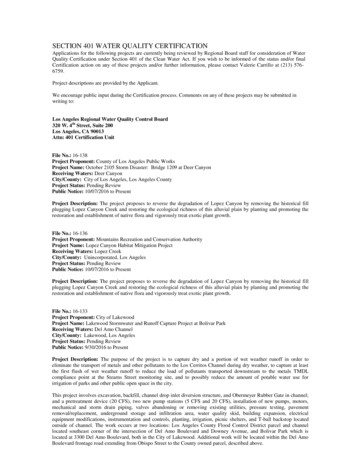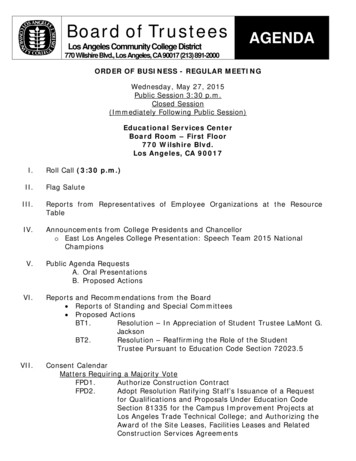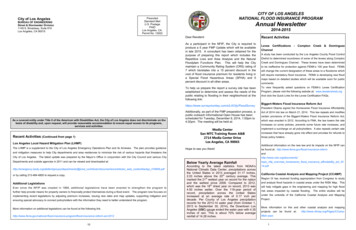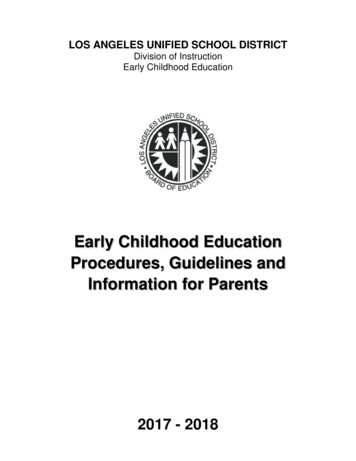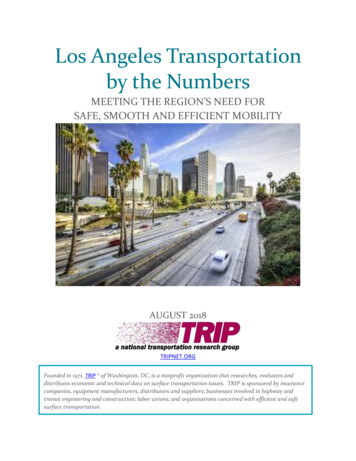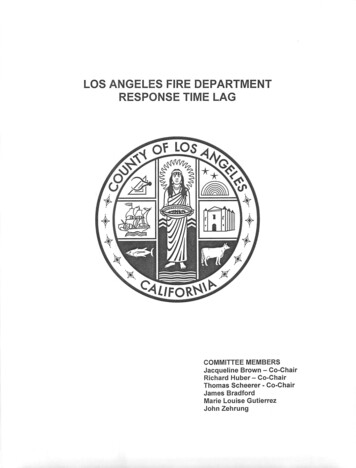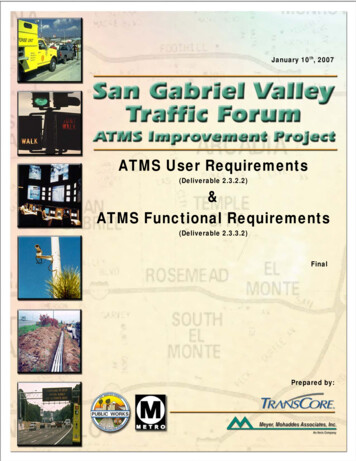
Transcription
January 10th, 2007ATMS User Requirements(Deliverable 2.3.2.2)&ATMS Functional Requirements(Deliverable 2.3.3.2)FinalPrepared by:
SAN GABRIEL VALLEY TRAFFIC FORUMDeliverable 2.3.2.2 – ATMS User Requirements (Final)Deliverable 2.3.3.2 – ATMS Functional Requirements (Final)FINALPrepared for:Los Angeles County Department of Public WorksPrepared by:626 Wilshire Blvd.Suite 818Los Angeles, California 90017January 10th, 2007
ATMS User & Functional Requirements – FinalTABLE OF CONTENTSPAGE#1. INTRODUCTION. 1-11.11.21.31.41.51.6Project Overview . 1-1San Gabriel Valley Traffic Forum. 1-1Countywide Information Exchange Network . 1-1Project Areas & Agencies Involved. 1-3Purpose of Document . 1-3Referenced Documents . 1-42. REQUIREMENTS . 2-12.1Definitions. 2-13. SYSTEM REQUIREMENTS. 3-13.13.23.33.43.53.63.73.8General Requirements . 3-43.1.1 System Overview . 3-43.1.2 Inter-Jurisdictional Coordination . 3-43.1.3 Involved Stakeholder Agencies . 3-43.1.4 System Architecture . 3-5System Status . 3-7System Control . 3-8User interface . 3-113.4.1 Ease-of-Use (General) . 3-113.4.2 Multi-User Capability . 3-143.4.3 Confirmation & Error Checking. 3-153.4.4 Progress Indicator . 3-153.4.5 Tool Bar & Status Bar. 3-153.4.6 Operator Error Message. 3-163.4.7 System Error Message. 3-163.4.8 Multi-Tasking Capabilities . 3-173.4.9 Map Displays & Real-Time Displays . 3-17Report Generation . 3-243.5.1 General Requirements . 3-243.5.2 Equipment Reports. 3-263.5.3 Communications Reports . 3-263.5.4 Detector Fault Reporting . 3-273.5.5 Detector Reports . 3-273.5.6 Maintenance Log Reports . 3-28Database Editing & Recovery. 3-29System Security & Access. 3-31ITS Systems & Components. 3-343.8.1 ATMS – Genral Requirements . 3-343.8.2 ATMS – Traffic Control Modes . 3-353.8.3 ATMS – Upload/Download Features . 3-373.8.4 ATMS – Traffic Responsive. 3-393.8.5 ATMS – Manual Control Modes . 3-393.8.6 ATMS – Monitor Signals. 3-40San Gabriel Traffic ForumPage iJanuary 10th, 2007
ATMS User & Functional Requirements – Final3.93.103.113.123.133.143.8.7 ATMS – Maintain Signals . 3-403.8.8 ATMS – Synchronize Clocks . 3-413.8.9 ATMS – Generate Timing Plans. 3-423.8.10 ATMS – Manage Timing Plans. 3-423.8.11 ATMS – Schedule Operations. 3-433.8.12 ATMS – Temporary & Permanent Commands. 3-443.8.13 ATMS – Exchange Coordination Data . 3-443.8.14 ATMS – Monitor Congestion . 3-453.8.15 ATMS – Repair Equipment . 3-453.8.16 ATMS – Configure Operations . 3-463.8.17 ATMS – Command/Data Interface to the Countywide IEN. 3-463.8.18 Detection System . 3-463.8.19 Closed Circuit Television System – General Requirements. 3-483.8.20 CCTV System – View Images . 3-493.8.21 CCTV System – Control Cameras . 3-493.8.22 CCTV System – Select Cameras . 3-513.8.23 Changeable Message Sign System – General Requirements . 3-523.8.24 CMS System – Message Development. 3-553.8.25 CMS System – Sign Plans . 3-553.8.26 CMS System – Scheduling . 3-553.8.27 CMS System – Message Library. 3-563.8.28 CMS System – Control Signs. 3-563.8.29 Incident Management. 3-573.8.30 Transit Priority Systems . 3-583.8.31 ATMS – Emergency Vehicle Pre-Emption . 3-583.8.32 ATMS – Communications . 3-583.8.33 ATMS – Future ITS Elements . 3-59ATMS Data collection . 3-593.9.1 General Requirements . 3-593.9.2 Data Archiving . 3-623.9.3 Analyze Data . 3-62Event Logs & Alarms . 3-63ATMS Users . 3-653.11.1 Network Administration . 3-653.11.2 System Administration . 3-653.11.3 System Users. 3-66System Performance . 3-673.12.1 Reliability. 3-673.12.2 Equipment Technology . 3-673.12.3 Performance Measures. 3-68ATMS Facility . 3-693.13.1 Coordination Requirements . 3-69Operation & Maintenance . 3-694. APPENDIX A – ACRONYMS/DEFINITIONS. 4-1San Gabriel Traffic ForumPage iiJanuary 10th, 2007
ATMS User & Functional Requirements – Final1.1.1INTRODUCTIONPROJECT OVERVIEWThe Los Angeles County Department of Public Works (County) Traffic Forum Program hasproven successful in creating institutional infrastructure to coordinate the activities of theAgencies responsible for traffic signal operations in LA County. These Traffic Forums allowgroups of bordering Agencies to work together to promote inter-Agency cooperation. TheTraffic Forums have enabled funding to be targeted at infrastructure improvements along arterialand arterial/freeway corridors in the County’s sub-regions. Such projects are a critical part ofwhat will eventually be a network of integrated Intelligent Transportation Systems (ITS) projectsin LA County and in Southern California.1.2SAN GABRIEL VALLEY TRAFFIC FORUMThe San Gabriel Valley Traffic Forum (SGVTF) project is one such project that will result inarterial infrastructure improvements within the project boundaries. The SGVTF project arearanges from the CA SR 110 and I-710 freeways to the west, I-210 freeway to the north, CA SR57 freeway to the east, and the CA SR 60 freeway to the south. It encompasses 24 municipalitiesas well as unincorporated portions of LA County. The traffic signals in the Region are operatedby many of the individual Agencies, the County, and Caltrans District 7.The goal of the SGVTF project is to design, develop, and deploy an Advanced TrafficManagement System (ATMS) specifically tailored to each Agency’s operations in the Corridorso that traffic signals can be synchronized and ITS systems integrated across jurisdictionalboundaries. The SGVTF project focuses on the specific needs of each Agency to manage itsATMS and recommends improvements to field infrastructure (e.g., controllers, detectionsystems, communications, etc.) and centralized Traffic Control Systems (TCSs) and/orTransportation Management Centers (TMCs) to meet those requirements. When the SGVTFproject is successfully completed, each of the Agencies responsible for traffic signal operationswill have full access to an ATMS that monitors and controls the traffic signals within itsjurisdiction. In addition, Agencies will be able to synchronize their signals and exchange trafficinformation in real-time with neighboring Agencies. This will allow the Agencies to respond torecurrent and non-recurrent congestion in a coordinated fashion across jurisdictional boundaries.1.3COUNTYWIDE INFORMATION EXCHANGE NETWORKDeveloped by the County, the Countywide Information Exchange Network (IEN) is theintegrated system framework that connects all of the individual Agency ATMSs into a Regionalnetwork to support the operational goals identified above. As shown in Exhibit 1.1, theCountywide IEN supports traffic signal operations in three (3) levels: Local Level Comprises day-to-day traffic signal operations and maintenance (O&M) activitiescarried out by the individual Agency Includes activities such as signal timing, equipment monitoring, response to localtraffic conditions and events, etc.San Gabriel Traffic ForumPage 1-1January 10th, 2007
ATMS User & Functional Requirements – Final Corridor Level Supports inter-Agency coordination and joint signal operations within theparticular Traffic Forum (or Sub-Region) Includes activities such as signal coordination across jurisdictional boundaries,monitoring and exchange of local traffic data throughout the Corridor, jointresponse to traffic conditions, incidents, and events that affect more than onejurisdiction, etc.Regional Level Permits arterials of Regional significance to be monitored, managed, andcontrolled as a single entity Supports multi-Agency, cross-Corridor data exchange permitting a Countywideresponse to traffic conditions and major events Facilitates communications between systems/Agencies not part of a TrafficForum (e.g., Caltrans, LADOT, etc.).Exhibit 1.1 – Countywide IENThe SGVTF assumes the availability of the Countywide IEN at the Corridor and Regional levels.Therefore, the SGVTF project is focused on the selection of TCSs and the integration of thosesystems to the Countywide IEN at the local level. The eventual ATMS design for the SGVTFwill take into account the interface to the IEN and its requirements at the Local level andencompass the following six (6) core components: ATMS and/or TCS (Individual Agency)Detection and SurveillanceTMC and/or W/S Layouts (ATMS and/or IEN)San Gabriel Traffic ForumPage 1-2January 10th, 2007
ATMS User & Functional Requirements – Final Communications NetworkSGVTF Participation/Coordination (City-specific and/or SGVTF-Regional integration)Operations & Maintenance (O&M)The Countywide IEN comprises the series of computer servers, communications, networks,graphical user interface (GUI) displays, etc. that integrates these components for thecollection/transfer of data to support Corridor and Regional functions throughout LA County.1.4PROJECT AREAS & AGENCIES INVOLVEDThe SGVTF Project encompasses several jurisdictions. Furthermore, it will be integrated, orhave the ability to integrate with other projects and existing systems in the Region through theCountywide IEN. SGVTF Project Stakeholders include 22 local Agencies, the County, andCaltrans District 7 as the table below indicates:City of ArcadiaCity of AzusaCity of DuarteCity of GlendoraCity of La PuenteCity of MontebelloCity of PasadenaCity of San DimasCity of San MarinoCity of South El MonteCity of Temple CityLA County Dept. of Public Works1.5City of AlhambraCity of Baldwin ParkCity of CovinaCity of El MonteCity of IrwindaleCity of MonroviaCity of Monterey ParkCity of RosemeadCity of San GabrielCity of South PasadenaCity of West CovinaCaltrans District 7PURPOSE OF DOCUMENTThis document represents the following deliverables: Deliverable 2.3.2.1 – ATMS User Requirements (Draft)Deliverable 2.3.3.1 – ATMS Functional Requirements (Draft)The above sub-tasks within the SGVTF’s Task 2.3 – Operational Concept and SystemRequirements were performed in parallel due to the close nature of the work activities involvedwithin each. Due to the fact that functional requirements are inter-related with userrequirements, both have been combined into a single document.The objective of this report is to identify ATMS user and functional requirements for theSGVTF. The intent is that these requirements will form the basis for the detailed design andimplementation of the ATMS improvements within the SGVTF. The success of the Project willbe dependent upon each involved Agency's active participation in identifying critical issues andimplementing systems to respond to these issues. In previous tasks, the TransCore Teaminvestigated/analyzed the existing ITS system inventory, identified operational objectives andsystem needs, and developed the concept-of-operations for the SGVTF Project Stakeholders.Building upon these findings, this document defines the ATMS user and functional requirementsSan Gabriel Traffic ForumPage 1-3January 10th, 2007
ATMS User & Functional Requirements – Finalfor the SGVTF Agencies so that systems can be designed and implemented that will support andaddress these needs.1.6REFERENCED DOCUMENTSThe following documents have been used as reference material in the preparation of this report: San Gabriel Valley Traffic Forum Project Deliverable 2.1.2 – Operational Objectives Deliverable 2.2.2 – System Needs Deliverable 2.3.1.1 – Concept-of-OperationsI-5/Telegraph Road Corridor Project Deliverable 3.1.2 – Advanced Traffic Management System (ATMS) UserRequirementsI-105 Corridor Project TSMACS User Requirements Report (Final) Functional Requirements Report (Draft)San Gabriel Valley Pilot Project System Design Report (Final, Version 1.0)South Bay Traffic Signal Synchronization and Bus Speed Improvement Plan –Part III Deliverable 2.2.4 – Final Local Traffic Control Center(s) Facility and ComputerSystem RequirementsSan Gabriel Traffic ForumPage 1-4January 10th, 2007
ATMS User & Functional Requirements – Final2.REQUIREMENTSThe User Requirements represent the first layer of requirements for the SGVTF Project. TheUser Requirements specify the capabilities of the system from the user’s perspective in terms auser can understand. This generates a common understanding of the systems by both the users aswell as developers.Once the User Requirements have identified the capabilities of the system, the second layer ofrequirements is the development of the Functional Requirements. Typically, the FunctionalRequirements identify the elements of the system that are required to implement the userrequirements. This procedure enables a systematic approach to the first level of systemarchitecture.The Functional Requirements describe the major system functions for each of the core systemcomponents. In addition, all required system capabilities are expressed using “shall” statementsto further indicate what the system must do and/or accomplish.The Functional Requirements presented in this report comprise a combination of therequirements for the Agencies in the SGVTF area. Preparing the functional requirements for aspecific system usually comprises the selection of the relevant requirements based upon theinformation contained in the User Requirements that detail Agency-specific features.2.1DEFINITIONSWithin this document, the following definitions are used: ATMS The SGVTF ATMS elements/components that are controlled and operated by acentralized computer systemUsersSGVTF ATMS Project Stakeholder Agencies that use the System Includes operators, maintenance technicians, operational supervisors, etc. It should be noted that not all users will have the same operational responsibilitiesor authority for control or operations of the ATMSAdministrators Users who maintain ultimate authority on system control, operations, andmaintenance of the system and system elements over their own jurisdictionsOther Users Users who have no operational responsibilities and authority for control andoperations of the system and the system elements. It can be used fordemonstration, training, etc. purposes. The control and operations of the ATMS must be governed by system hierarchy levels, priorities,standard operating policies and procedures, and Memoranda of Understandings (MOUs) (ifneeded). These issues must be addressed during detail design for final agreement by all ProjectStakeholders.San Gabriel Traffic ForumPage 2-1January 10th, 2007
ATMS User & Functional Requirements – Final3.SYSTEM REQUIREMENTSThe following sub-sections identify the key User Requirements and Functional Requirements forachieving advanced traffic management within the SGVTF project area. Each sub-section ismade-up of relevant User Requirements and derived Functional Requirements. FunctionalRequirements have been derived from the documents identified in Section 2.2, the CountywideIEN program, and current industry standards.The following numbering convention is adopted in this document with regards to therequirement numbers. The alpha-numeric system by which the requirements are listed will be“type (ATMS) “subject”-“requirement”, such as “ATMS-TCS-U1”, for ATMS, Traffic ControlSystem, User Requirement #1. The first functional requirement in the same section will be listedas “ATMS-TCS-F1 and so on. For purposes of presentation and ease of use, this structure andthe requirements information will be transferred into a tabular format.All of the requirements have been grouped into the operational/categorical classifications thatfollow in order to provide better ease of reference for the reader as well as to group similarand/or associated requirements in one (1) location: General Requirements – Groups together functionality and system characteristics thatdo not apply to a specific category. System Overview Inter-Jurisdictional Coordination Involved Stakeholder Agencies System ArchitectureSystem Status – Groups together the characteristics associated with the current operatinglevel(s) of the system.System Control – Groups together the characteristics associated with the controlcapabilities/functionality of the system.User Interface – Groups together the characteristics associated with the User’s ability toview/monitor, interact/control, and input data/information with the system. Ease-of-Use Multi-User CapabilityConfirmation & Error Checking Progress Indicator Tool Bar and Status Bar Operator Error Message System Error Message Multi-Tasking Capabilities Map Display & Real-Time DisplaysSan Gabriel Traffic ForumPage 3-1January 10th, 2007
ATMS User & Functional Requirements – Final Report Generation – Groups together the characteristics associated with the system’sability to notify the User of system operations or status in the form of printed reports. General Requirements Equipment Reports Communication Reports Detector Fault Reporting Detector Reporting Maintenance Log ReportsDatabase Editing – Groups together the characteristics associated with the system’sability to input, store, and retrieve data/information.System Security and Access – Groups together the characteristics associated with thesystem’s ability to provide/restrict access to the system by various levels of Users and/orAdministrators.ITS Systems & Components – Groups together the characteristics associated with thesystem’s ability to provide the required ATMS functionality and operation. General Requirements Advanced Traffic Management System (ATMS) Traffic Control Modes Upload/Download Features Traffic Responsive Manual Control Modes Monitor Signals Maintain Signals Synchronize Clocks Generate Timing Plans Manage Timing Plans Schedule Operations Temporary & Permanent Commands Exchange Coordination Data Monitor Congestion Repair Equipment Configure Operations Command/Data Interface (CDI) to the IEN Detection System Closed Circuit Television (CCTV) System View Images Control Cameras Select Cameras Changeable Message Sign (CMS) System Message Development Sign Plans Scheduling Message Library Control Signs Incident Management Transit Priority Systems Emergency Vehicle Pre-EmptionSan Gabriel Traffic ForumPage 3-2January 10th, 2007
ATMS User & Functional Requirements – FinalCommunicationsFuture ITS ElementsATMS Data – Groups together the characteristics associated with the system’s ability tocollect, process, share, and store data. General Requirements Data Archiving Analyze DataEvent Logs & Alarms – Groups together the characteristics associated with the system’sability to monitor, store, and inform the User of its current operating status.Users – Groups together the characteristics associated with the User’s ability to interactwith the system. Network Administration System Administration System OperatorsSystem Performance – Groups together the characteristics associated with the system’sability to provide the required functionality in a reliable and timely manner. Reliability Scalability Equipment Technology Performance MeasuresOperations & Maintenance (O&M) – Groups together the characteristics associatedwith the system’s general operations and maintenance principles. San Gabriel Traffic ForumPage 3-3January 10th, 2007
ATMS User & Functional Requirements – Final3.13.1.1GENERAL REQUIREMENTSSystem OverviewUser RequirementsATMS-GEN-U13.1.2The ATMS shall implement a download/plan select, distributed controlphilosophy. Typically, the ATMS will support the ability of signal timingplans being developed and stored in a central location and able to bedownloaded to the local field controller.Inter-Jurisdictional CoordinationUser RequirementsATMS-GEN-U2The ATMS shall provide seamless traffic flow operations betweenjurisdictions.ATMS-GEN-U3The ATMS shall be capable of viewing all traffic signals and monitoringroadway traffic conditions within its jurisdiction [as well as thejurisdiction(s) that it “hosts”.ATMS-GEN-U4Through the ATMS, one Agency shall be able to request/implement planchanges in other Agencies systems (that share and/or are connected to it) toaccommodate emergency operations and/or non-recurrent congestionsituations.ATMS-GEN-U5The ATMS shall develop/support a CDI based on the “IEN CDIRecommendations” document for inter-jurisdictional information sharingand exchange, control, and operations.ATMS-GEN-U6The ATMS shall support transit priority systems (TPS), bus signal priority(BSP) systems, transit signal pre-emption, etc. between transit operatorsand local Agencies in relation to transit routes, LRT, and transit priority.3.1.3Involved Stakeholder AgenciesUser RequirementsLos Angeles County Department of Public Works (LACODPW)ATMS-GEN-U7LACODPW shall have operational control of traffic signals within itsjurisdiction.San Gabriel Traffic ForumPage 3-4January 10th, 2007
ATMS User & Functional Requirements – FinalATMS-GEN-U8LACODPW shall be able to perform operational monitoring (phasedisplay, real-time plan data, alarms, etc.) and functional monitoring(alarms, fault reporting, etc) for all traffic signals in their jurisdiction aswell as for all traffic signals for those Agencies that they “host” on theLACO TCS.California Department of Transportation (Caltrans)ATMS-GEN-U9Caltrans shall have operational control of arterial traffic signals within itsjurisdiction.ATMS-GEN-U10Caltrans shall be able to perform operational monitoring of all trafficsignals within the SGVTF Region (e.g., phase displays, real-time plan data,etc.)SGVTF Stakeholder Agencies/CitiesATMS-GEN-U11SGVTF Stakeholder Agencies/Cities shall have operational control oftraffic signals within their jurisdiction.ATMS-GEN-U12SGVTF Stakeholder Agencies/Cities shall be able to perform operationalmonitoring (phase display, real-time plan data, alarms, etc.) and functionalmonitoring (alarms, fault reporting, etc) for all traffic signals in theirjurisdiction as well as for all traffic signals for those Agencies that they“host” on their ATMS.ATMS-GEN-U13SGVTF Stakeholder Agencies/Cities shall be able to re-direct control oftheir ATMS to alternate Agencies.3.1.4System ArchitectureUser RequirementsATMS-GEN-U14The ATMS shall be consistent with the County’s IEN Architecture.ATMS-GEN-U15The ATMS shall be modular and scaleable.ATMS-GEN-U16The ATMS hardware shall have networking capability.ATMS-GEN-U17The ATMS shall be based on web based or client-server architecture.ATMS-GEN-U18The ATMS shall use industry standard processors and networkcomponents.ATMS-GEN-U19To the greatest extent possible, the ATMS shall be designed/support an“open” system architecture format (as described herein) to allowflexibility, interoperability, and future expansion of the system to meetfuture needs.San Gabriel Traffic ForumPage 3-5January 10th, 2007
ATMS User & Functional Requirements – FinalFunctional RequirementsATMS-GEN-F1The ATMS shall use the latest version of Microsoft’s multi-taskingoperational system for Intel-architecture PC-based servers in a client-serverarchitecture.ATMS-GEN-F2The ATMS workstations shall use the latest version of Microsoft’s multitasking operational system for Intel-architecture PC-based servers in aclient-server architecture.ATMS-GEN-F3The Supplier shall place the source code for all such restrictive softwarethat has been placed under configuration management and control (i.e.,software required to edit or alter the source code and successfullyrecompile and operate the software, including operating systems, libraries,tools and utilities, database structures and code, and compilers, including alist of all software documentation tools) in escrow, accompanied bydetailed source code documentation, including a list of applicable softwaredevelopment tools.ATMS-GEN-F4Source Code shall be updated in conjunction with all ConfigurationManagement plans/activities at least annually, or earlier, if the Supplierissues an update that contains substantial revisions to the software.ATMS-GEN-F5Source Code shall be released in the event that the Supplier is unable todeliver services (including warranty services, maintenance, upgrades, bugfixes, and expanded features.ATMS-GEN-F6Upon release of the Source code under these terms, the Client shall have aroyalty-free, non-transferable, non-exclusive license to use, for the Client’sATMS purposes only, the machine-readable/executable software.ATMS-GEN-F7The central ATMS software shall be capable of handling a minimum of upto twice (2x) the number of intersections currently under the control of theAgency.ATMS-GEN-F8Detector data shall be collected and stored in
within each. Due to the fact that functional requirements are inter-related with user requirements, both have been combined into a single document. The objective of this report is to identify ATMS user and functional requirements for the SGVTF. The intent is that these requirements will form the basis for the detailed design and
